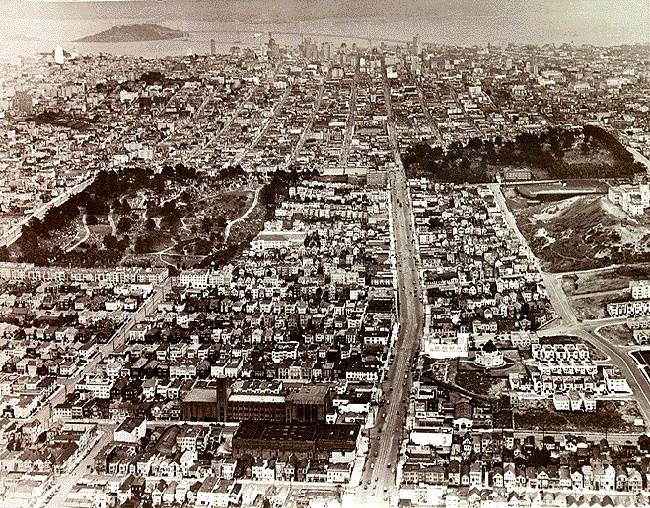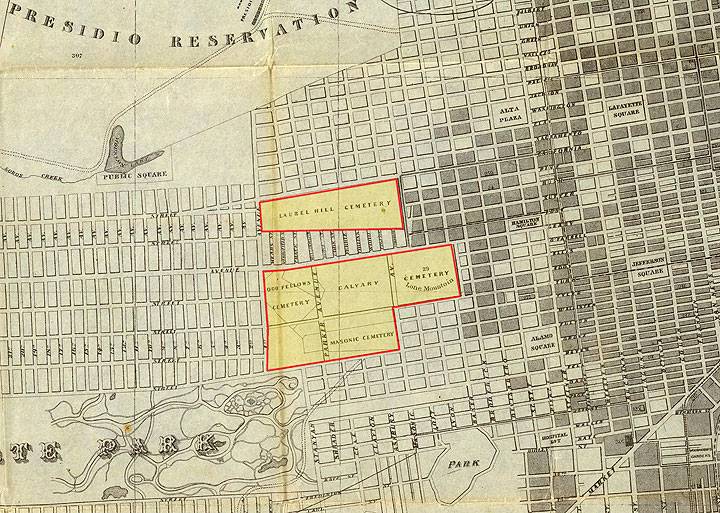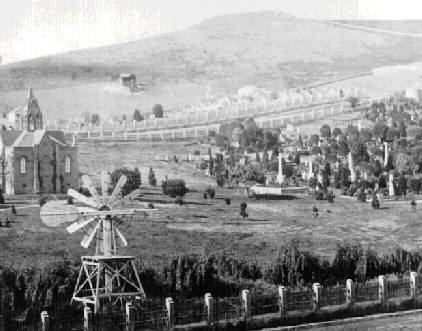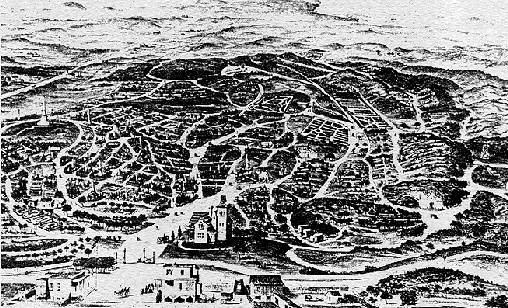Old Cemeteries in the City: Difference between revisions
(added new photo) |
(Changed credits from Greg Garr to Private Collection) |
||
| Line 5: | Line 5: | ||
'''Bird-eye view of the Richmond District, looking east in 1938. The Columbarium is the round structure, lower right.''' | '''Bird-eye view of the Richmond District, looking east in 1938. The Columbarium is the round structure, lower right.''' | ||
''Photo: | ''Photo: Private Collection, San Francisco, CA'' | ||
[[Image:Cemetery-map-highlighted 1873.jpg]] | [[Image:Cemetery-map-highlighted 1873.jpg]] | ||
| Line 52: | Line 52: | ||
'''Laurel Heights Cemetery during the 1890s, sprawling into the sand dunes of the Inner Richmond area.''' | '''Laurel Heights Cemetery during the 1890s, sprawling into the sand dunes of the Inner Richmond area.''' | ||
''Image: | ''Image: Private Collection, San Francisco, CA'' | ||
Revision as of 13:42, 10 June 2014
Primary Source
Bird-eye view of the Richmond District, looking east in 1938. The Columbarium is the round structure, lower right.
Photo: Private Collection, San Francisco, CA
Big Four Cemeteries seen here on 1870 map.
Map: Courtesy David Rumsey]
The Jewish Cemetery at what is now Dolores Park in the Mission
pre-1850 Vacant lots were used for impromptu burials: Russian Hill (Jones & Vallejo); Clarke's Point (eastern side of Telegraph Hill); 1st & Clementina; North Beach (near Powell & Lombard)
1850 Yerba Buena Cemetery opens (8th & Market), site of former City Hall and future main library.
1854 Jewish Cemetery (Cow Hollow bounded by: Franklin, Gough, Broadway & Vallejo Sts.)
1860-61 Jewish community establishes two cemeteries: Nevai Shalome & Gibbath Olom (now Dolores Park)
1850s: Early San Francisco Cemeteries: Mission Dolores. Russian Hill. Telegraph Hill. North Beach, Yerba Buena, and Presidio.
1854: Laurel Hill Cemetery developed.
Late 1850s: Yerba Buena Cemetery abandoned.
1860: Calvary Cemetery, the Catholic Cemetery, developed on Lone Mountain.
1864: Masonic Cemetery developed.
1865: Odd Fellows Cemetery developed.
1880s: The cry "Remove the cemeteries!" began.
1887 Catholics establish Holy Cross Cemetery in Colma. On June 7, Timothy Buckley is the first to be interred in Colma.
1888 Jews establish Home of Peace Cemetery in Colma for bodies evicted from what is now Dolores Park.
1889 No more burials in Jewish cemeteries.
1889 Jews establish Hills of Eternity Cemetery.
Laurel Heights Cemetery during the 1890s, sprawling into the sand dunes of the Inner Richmond area.
Image: Private Collection, San Francisco, CA
1900: Most graveyards filled. Cemeteries deteriorating.
1900 Mayor James D. Phelan signs the order "prohibiting the burial of the dead within the city and county of San Francisco after the first day of August 1901."
1901 Board of Supervisors get permission to use City Cemetery as a park to raise Richmond property values.
1913 Board of Supervisors ordered all cemeteries closed and bodies removed. Voters overturned the ordinance.
1921: State legislation passed to allow cemeteries to be abandoned. Litigation followed.
1923: Second Morris Act passed allowing removal of bodies from cemeteries.
1924 City of Lawndale, later Colma, incorporated by the Associated Cemeteries.
1920s: Masonic and Odd Fellows Cemeteries' remains removed to Colma.
1920s: "Franciscan Heights" subdivision developed on Odd Fellows land. University of San Francisco purchased Masonic cemetery land. Jordan Park developed.
1927: St. Ignatius College moved to Fulton and Parker Streets.
1930: St. Ignatius renamed the University of San Francisco.
1930s: Removal of Laurel Hill and Calvary encouraged. Several plans discussed but had little support.
1932: San Francisco College for Women built on Lone Mountain.
1937: Catholic Archdiocese ceased opposition to removal of Calvary.
1937 Supervisors again ordered the "disinterring and removal of human bodies." Voters upheld the ordinance this time.
1939 Exhumations begin, not completed until 1948.
1941 The post office requires Lawndale to change its name, due to another post office by the name of Lawndale in Los Angeles County. Lawndale becomes Colma.
1930s/1940s: Removal of Laurel Hill and Calvary remains to Colma.
Calvary Cemetery after being cleared for redevelopment, August 26, 1946.
Photo: San Francisco History Center, SF Public Library
1940s/1950s: Development of Laurel Heights with residential homes and apartments.
1964: University of San Francisco became co-educational.
1978: University of San Francisco acquired Lone Mountain campus.
1980s: Columbarium renovated under ownership of Neptune Society.
1988: St. Ignatius High School torn down. Koret Recreational Center built.
1993 Excavation for the rebuilt Legion of Honor Museum at Land's End uncovers at least 700 bodies. There are many more still buried at Land's End.
more information is available from Trina Lopez's excellent documentary, "A Second Final Rest"





